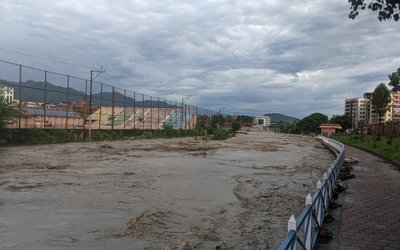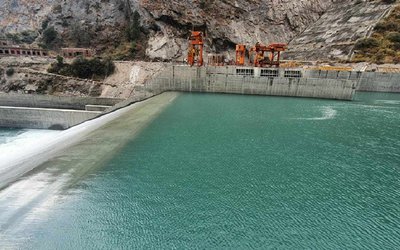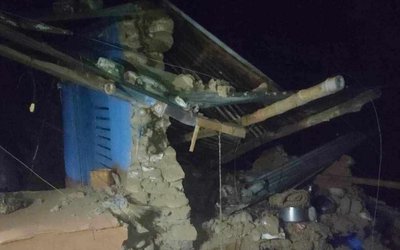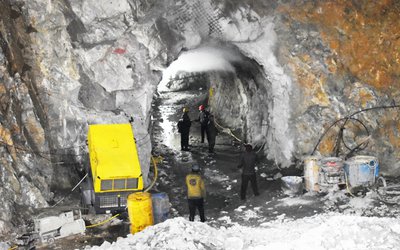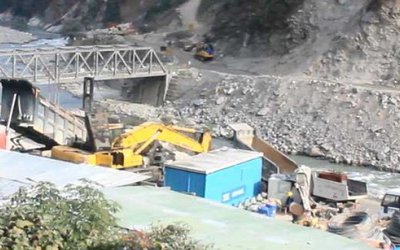
Finance Minister Dr. Yubaraj Khatiwada hailed the signing the agreement for the construction of 216 MW Upper Trishuli Project is an important milestone for the hydropower development of Nepal.
Finance minister Dr. Khatiwada said that this is for the first time when he saw so many important development partners are standing together to support a hydropower project.
He said that Nepal has amended several acts and regulations to make Nepal friendly to Foreign Direct Investment and urged investors to come to invest in Nepal.
IFC, a member of the World Bank Group, and a consortium of other lenders today finalized a $453 million debt financing package that will support the construction of a landmark hydroelectric plant in central Nepal. The plant will increase Nepal's electricity supply by one-third from today’s levels and provide clean, reliable power to some 9 million people, part of a larger effort by IFC to create markets and fight poverty in the country.
IFC is the lead arranger of the debt package, which includes eight other lenders, and is one of the largest foreign direct investments in Nepal’s history. The financing is being provided to the privately-owned Nepal Water and Energy Development Company. The firm will develop and operate a 216-megawatt, run-of-the-river hydroelectric plant on the Trishuli River about 70 kilometers north of Kathmandu. Officially known as Upper Trishuli-1, the project’s financing structure, competitive tariffs, and use of internationally accepted contract standards is expected to set a standard for future hydropower projects in Nepal.
"This project is a game-changer for Nepal," said Barshaman Pun, Nepal’s Minister of Energy. "Not only will it power hundreds of thousands of homes and businesses, but it will also serve as an of example of how private companies can help Nepal expand its hydropower sector and attract much needed foreign direct investment."
Nepal's rivers, fed by runoff from the Himalaya Mountains, could support 43 gigawatts of electrical generation capacity. But less than three percent of that has been developed. As well, the country has suffered from blackouts and brownouts, hampering businesses and making life difficult for residents.
"There is no question that Nepal has the potential to be an energy powerhouse," said Bo-Seuk Yi, the CEO of the Nepal Water and Energy Development Company. "To realize that promise, Nepal can enlist the help of private companies, which have the capital and expertise to make major projects a reality."
Passing through several hurdles in the last eight years including badly damaged by earthquake, Nepali investor Brindabanman Singh Pradhanang and Korean Partners tireless efforts paved the way to materialize the project.
Initiated during the period of current minister of Energy, Water Resources and Irrigation Barsha Man Pun as finance minister in 2012, financial closure of the project also has finalized during his tenure.
NEA’s managing director Kulman Ghising also facilitated for the construction of project signing PPA with the company a year ago.
The new hydroelectric plant is expected to be completed in 2024. Along with providing clean, reliable power to millions, it will set new environmental and social-impact benchmarks and enhance benefits for local communities. Furthermore, a cumulative impact assessment of existing and planned hydropower projects has been completed for the Trishuli basin, which will help guide sustainable development in the watershed.
“This project represents a significant milestone in the development of Nepal’s hydropower potential as it has been able to attract meaningful private sector participation, particularly from international investors,” said Mengistu Alemayehu, IFC Director for South Asia. “It also shows the unprecedented resilience and commitment by the government, the sponsors, and other stakeholders against all odds over the years, including a major earthquake. We expect this project to become a model for expanded investments in developing Nepal’s hydropower to meet the growing domestic demand and export to the neighboring countries.”
IFC and a consortium of Korean and Nepali partners, in collaboration with the Government of Nepal, have spent over seven years developing the Upper Trishuli-1 project, which is a prime example of IFC’s ability to create markets through upstream project preparation work over many years in low-income countries.
According to press release, the Nepal Water and Energy Development Company’s key owners are Korea South-East Power, Daelim Industrial, Kyeryong Construction Industrial, and IFC. IFC is providing $190 million in financing, including $95 million of equity and loans from its own account, and $95 million as the implementing entity for other funding sources. The Multilateral Investment Guarantee Agency, another member of the World Bank Group, will provide $135 million in guarantees to cover political risk for the sponsors. Other financiers include the Export and Import Bank of Korea, the Asian Development Bank, the Asian Infrastructure and Investment Bank, the Korea Development Bank, CDC (the United Kingdom’s development finance institution), FMO (the Dutch Entrepreneurial Development Bank), the OPEC Fund for International Development, and Proparco.
Because of its unique development impact, pioneering features, and demonstration to private investors, the project also includes support from the International Development Association’s Private Sector Window, a global facility of concessional funds to support high-impact private sector investments in lower-income countries, the Finland-IFC Blended Finance for Climate Program, and the Climate Investment Funds.
Nepal Water and Energy Development Company Private Limited (NWEDC) signed Financing Agreements with International Finance Corporation (IFC), Asian Development Bank (ADB), Asian Infrastructure Investment Bank (AIIB),Export-Import bank of Korea (K-EXIM), Korea Development Bank (KDB), CDC Group PLC (CDC), Netherlands Development Finance Company (FMO), PROAPRCO Development Financial Institution (PROPARCO), and The OPEC Fund for International Development (OFID) for the loan financing of Upper Trishuli-1 Hydropower Project amidst a special Signing Ceremony organized at Radisson Hotel, Kathmandu today.
While arranged by IFC, the loan agreements were signed to provide a total loan amount of USD 453.2 million for the Upper Trishuli-1 Hydropower Project. The loan amounts in USD signed with each of IFC, ADB, AIIB, K-EXIM, KDB, CDC, FMO, PROPARCO and OFID are 161.3 million, 60 million, 39.6 million, 100 million, 30.8 million, 21.9 million, 15.4 million, 11 million, and 13.2 million, respectively. The Bank of New York Mellon (BNY) as the Offshore Account Bank and Nepal Investment Bank (NIB) as the Onshore Account Bank were also parties to the Financing Agreements.
Dr. Yuba Raj Khatiwada, Minister for Finance and Barshaman Pun ‘Ananta’, Minister for Energy jointly witnessed the signing ceremony. The ceremony was also attended by more than 200 representatives from several Government entities like MOF, MOE, DOED, NEA, NERC, NRB, IBN, the Sponsors, Lenders, and local stakeholders.
NWEDC is the special purpose company established by the Project’s sponsors and shareholders for the development of Upper Trishuli-1 Hydropower Project. The Sponsors of the Project are Korea South East Power Co. Ltd. (KOEN), Daelim Industrial Co. Ltd., and Kyeryong Construction Industrial Co., Ltd., and IFC and a local partner will also be shareholders.
The equity shares up to 10% will be allocated for project affected people as per local shares provision in Project Development Agreement itself. The Main Sponsor, KOEN is a Korean government-owned power generation company which owns and operates more than 10,000 MW of power plants in Korea.

The Upper Trishuli-1 Hydropower Project, located in Rasuwa, will generate annual energy of 1,533 GWh from three power generating units of total installed capacity 216 MW. 38.75% of the total annual energy will be generated in dry season whereas the remaining 61.25% of energy will be generated in wet season.
The delivery point of such energy generated is the under-construction Trishuli-3B Hub substation in Nuwakot. The project components include 29.5m high dam in Trishuli River, 9.7km long headrace tunnel, 292m high vertical pressure tunnel and an underground powerhouse. The project is located near the Kathmandu load centre and can provide a firm power of 104 MW all round the year.
Upper Trishuli-1 is the first project in South Asia to successfully complete the process of Free Prior Informed Consent (FPIC) from the local indigenous people in the project area. FPIC is expected to help create a social license for successful project construction and operation.
The Project Development Agreement (PDA) of the project was signed between the Government of Nepal and the Company on 29th Dec 2016. The Power Purchase Agreement (PPA) was signed between the Company and Nepal Electricity Authority (NEA) on 28th Jan, 2018 based on the posted rate of NEA. In accordance with the Energy Emergency Action Plan and the USD PPA guidelines of the Government, the PPA includes a provision of Dollar payment only for the loan portion for the first 10 years, and such Dollar payment has been hedged through a Hedging mechanism where the Company will contribute one third of the hedging costs through Free energy to NEA.
The construction of the project will be done based on a fully wrapped EPC Contract. A Joint Venture of internationally renowned Korean companies - Daelim Industrial Co. Ltd. and Kyeryong Construction Industrial Co., Ltd. will carry out the main construction works.
NWEDC aims to start the main construction of the project in 2020 after the approval of the Financing Agreements by the Nepal Rastra Bank and after the fulfillment of other conditions in the signed Financing Agreement documents. The scheduled construction period of the project is 5 years. The pre-construction works including access road, construction camp Facilities, and Bailey bridge are currently ongoing.
- Weather Forecast: Partly To Generally Cloudy With Rain And Thunder Acrosss Nepal
- Apr 19, 2025
- Minister Dahal Directed To Complete The Dannune Portion Of Road Before Monsoon
- Apr 18, 2025
- Kanchenjunga Diamond Festival Being Celebrated From Today To Mark The 70th Anniversary Of The First Successful Ascent
- Apr 18, 2025
- RPP To Hold Protest In Restricted Areas Of Kathmandu On April 20
- Apr 18, 2025
- Weather Forecast: Partly Cloudy With Rain And Thunder In Kathmandu, Pokhara, Biratnagar And Janakpur
- Apr 18, 2025
